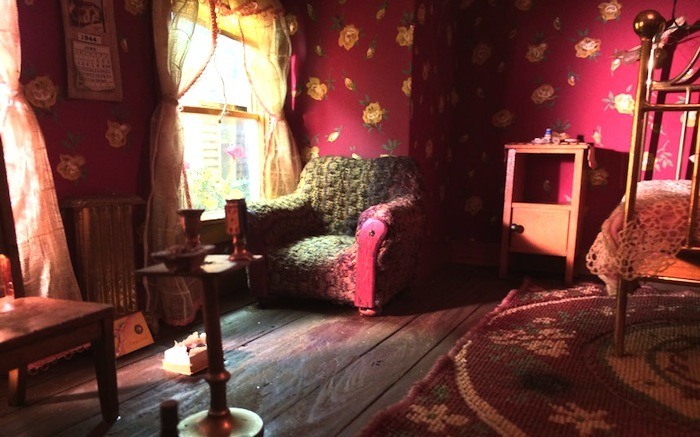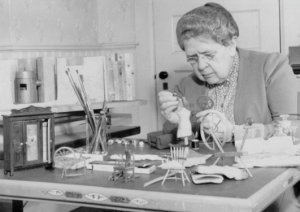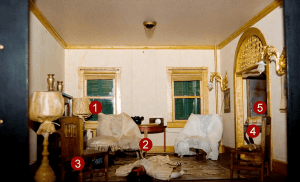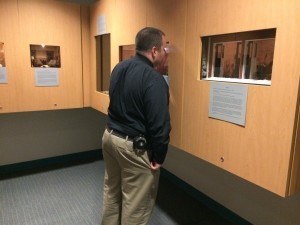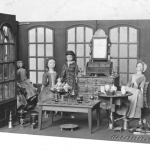The Nutshell Studies of Unexplained Death
Through the 1940s and 1950s, Frances Glessner Lee hosted a series of semi-annual seminars in homicide investigations at Harvard University. Using intricately constructed dioramas of actual crime scenes, complete with working doors, windows and lights, Frances taught detectives, prosecutors, and other investigators to solve real crimes with the “Nutshell Studies of Unexplained Death.”
How did a woman who was home-schooled and not allowed to go to college become one of the foremost teachers of forensic sciences and the first woman to become a member of the International Association of Chiefs of Police? Mainly with miniatures.
Growing Up
Frances Glessner was born in Chicago in 1878. Her father, John Jacob Glessner, made his fortune with International Harvester. He was an avid collector of fine furniture, with which he furnished the family home, now the John J. Glessner House Museum.
When it was time to go to college, her older brother was off to Harvard. But it was felt a college education was not appropriate for a young socialite. Frances stayed home, married a lawyer, then divorced the lawyer and for the next twenty-five years learned the domestic arts of interior design, sewing, knitting, crocheting, embroidery, painting, and metalwork from her female relatives.
Interest In Forensics
Frances’ interest in forensics was peaked by a classmate of her brother’s, George Burgess Magrath, who studied medicine at Harvard Medical School and became interested in death investigation. The whole idea was abhorrent to the family. Her father was supposed to have said, “a proper young woman shouldn’t know anything about the human body.”
After her brother’s death in 1930, Frances inherited the International Harvester fortune and finally started a career at age fifty-two. Poppa would not have been pleased.
Forensic Career Begins
George Magarth had become the chief medical examiner in Boston, and Frances joined his campaign to have coroners replaced by medical professionals nationally. Besides hard work, she put her money to good use, endowing Harvard Departments of Legal Medicine, Associates in Police Science and a criminal library. These are worthy institutions providing valuable education to law enforcement even to today, But Frances Glessner Lee’s crowning achievement may have been the twenty dioramas she built to change the way crime investigation was taught.
The Sherlock Holmes Influence
Frances had always been a fan of Sherlock Holmes stories, whose plot twists were often the result of overlooked details. She coupled this with those domestic arts she learned from female relatives, particularly interior design. Metalwork and painting would also be critical in creating twenty dioramas based on challenging homicide cases. They were designed to test the abilities of students to collect all relevant evidence.
Gruesome Miniatures
The models depicted multiple causes of death and were based on autopsies and crime scenes that she had visited. She paid extraordinary attention to detail in creating the models. The rooms were filled with working mousetraps and rocking chairs, food in the kitchens, and more. The corpses accurately represented discoloration or bloating that would be present at a crime scene. Students were given 90 minutes to study the scene, with these instructions:.
“The information supplied concerning each model is that which the officer would normally have when sent to investigate, together with the first statements obtained from one or more of the most immediately accessible witnesses. It must not be overlooked that these statements may be true, mistaken, or intentionally false, or a combination of any two or all three of these. The observer must, therefore, view each case with an entirely open mind. The Nutshell Studies are not presented as crimes to be solved―they are, rather, designed as exercises in observing and evaluating indirect evidence, especially that which may have medical importance.”
Death In Diorama
The link in the Parsonage crime scene leads to the “Explore” tab of the Death in Diorama website. Pictures of these miniatures not only show what great detail Frances built into them, and give you an idea how eighteen of them are still being used in forensic studies. But sadly, not at Harvard.
Baltimore Bound
On Frances Glessner Lee death in 1962, the programs she funded at Harvard (including the week-long seminars) were ended, and the Nutshells were put in storage, possibly headed for the trash.
Russell Fisher, the medical examiner in Baltimore and a former student of Lee’s programs at Harvard, stepped in and arranged for the State of Maryland would take over the seminars. The Nutshells Studies were brought to Baltimore in 1968 and are still used today to teach homicide investigation techniques.
It is fitting that the dioramas are kept in the Gallery in the Baltimore Medical Examiner’s office for public viewing, when not in use as teaching tools.
Susan Downing, with Patrick Owens
_________________________________________________________________________


